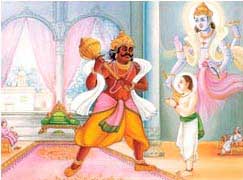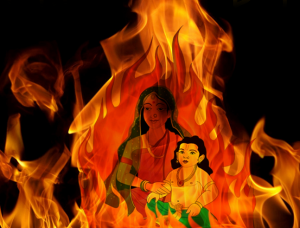The Festival of Holi-The story of Prahlad
Hiranyakashypu was the king of the asuras (demons). Hiranyakashypu’s brother had been slain by Vishnu for terrorising gods and goddesses. So Hiranyakashypu wanted to destroy Vishnu and keep other Gods in heaven subdued. He told his soldiers to crush all those who worship Vishnu, but the Gods protected the Devotees of Vishnu.
Hiranyakashypu thought to himself “I will have to match my powers to Vishnu’s to rule over the three worlds”.
So he began to perform severe penances and tapasya. While he was so occupied the Gods ransacked his city and destroyed his palace. Hiranyakashiapu’s Queen, who was expecting a child was sent by the gods to Sage Narada’s hermitage. She lived in the Ashram of the great sage and learned about religion and the glory of Vishnu from him. The child within her, Prahlad, too, absorbed all this knowledge.
Narada taught the Queen that Vishnu is the soul of all created things and is present everywhere. Meanwhile, Hiranyakashypu’s austerities pleased Brahma and said: “Arise Hiranyakashypu. Any boon that you ask of me shall be yours”.
Hiranyakashypu said I wish that my death be not caused by man or beast, with a weapon or without a weapon, during day or night, indoors or outdoors, on earth or in the sky. Grant me the undisputed lordship over the material world.
Hiranyakashypu brought his wife back to his city where Prahlad was born. Hiranyakashypu, with his new powers renewed his hostilities against Vishnu and Vishnu’s followers. He declared “There is non stronger than I. I am the lord of the three worlds. I shall be worshipped as such”.


